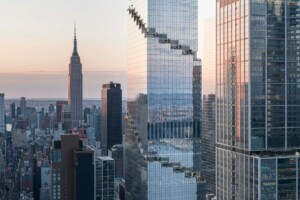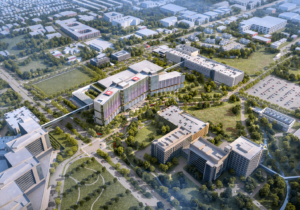As the days continue to wane until the 2020 Southeast Facades+ Conference on December 15, AN’s virtual summit on all things materials and facades for the region, we caught up with Perkins&Will’s David Crabtree to talk all things timber, human-centric designing, and more ahead of his co-chairing the conference.
With the Southeast Facades+ Conference just a few days away, what are some of the topics you’re excited to dive into over the conference’s virtual panels?
David Crabtree: A handful of topics. The idea of buildings for people and buildings for healing the environment. It’s one thing to have buildings that are sustainable, but—mass timber for example—anything we build with mass timber encapsulates carbon and does more good to heal the environment than otherwise. The energy is better. Also, thinking through the lens of high performance buildings and occupations—oftentimes we get into thinking about buildings being great for this or great for that, but then it’s not great for the people in it. When you start thinking about them in the design, it’s the mediating element between the people, their uses, and the outside world. It’s not just about keeping the sun out or the cold out, it’s about the human experience that happens to be doing those other things. Those are things that interest me. I do enjoy the tech side as we get into putting buildings together from old school builder-maker to parametric based softwares.
You bring an interesting idea with the pragmatic aspects of what a building needs to be for a client before anything else. Are there any projects from your own or the firm’s experience that dealt with that need that you’re particularly proud of?
I mean there are many. The Sarasota Police Headquarters, which I did in a past life, really deals particularly with the facade side with the things I’ve mentioned—mediating the environment and responding to solar gains and high-performance facades. It also created a beacon of light, because it’s a backlit, double-screened, polycarbonate dual facade. At nighttime, this thing becomes a glowing beacon, which most people assume police headquarters are bunkers, and barricades with tiny slit windows, instead of a glowing beacon of community outreach on the skyline. Those are personal things that were successes of mine.
For Perkins&Will, the projects are too numerous. We’re working on some mass timber projects now that are working to heal the environment, but we’re working on the regional aspect of how things are made, inspired by the farm culture of barns, that became a pavilion.
Living and working in the south with the different climates, including a regular hurricane season, how does that factor into the design planning of a project, deciding between steel or mass timber or other facade types to stand up to expected elements?
What’s interesting is that mass timber is strong through its weakness. It’s actually pound-for-pound stronger than steel when you consider what its weight is and what it actually does. We’re designing high rise projects in mass timber. I think that’s where mediating the environment is important, because you do these projects in the Florida sun, and breaking down light and shade and shadow and airy, filled projects, we’re trying to break down winds and breezes and channel air through things. When you have hurricanes, they break down the scale of the wind speeds and the wind damages. Many of those older buildings are still standing. They were never built to be hurricane tolerant, but they are. You have hundreds of year old structures, certainly through Key West, that were built out of timber. They’ve lasted a hundred years.
That said, in your opinion, one of the largest gaps for mass timber’s proliferation would be a perception issue, right?
Yeah, and when I’m presenting on mass timber, there are 200-foot-tall temples in japan that are made out of heavy timber. We call it mass timber because we’re constructing heavy timber out of new growth wood so we can essentially re-grow a building in four or five minutes based on the world’s production of wood. It’s very good in fires. Little stick-built stuff, the stuff people think of from the seventies and eighties that gets thrown up in a few weeks, that’s not longevity. That doesn’t help the perception of wood. Even the insurance companies. They’ll say, “Oh, you’re building in wood? You must be one of those multi-family two-foot sticks and cardboard.” Mass timber is a completely different animal.
Perkins&Will has a massive amount of reach across the world and works on a lot of larger-scale projects. You’re moderating a panel on residential projects though. Having worked with large and small scale projects over your tenure, what are some lines you can draw between both approaches?
I enjoy small-scale projects. In many ways, they’re more difficult to do. They’re more personal to the people, so everybody’s paying attention to every decision. Mainly, it’s about coming around a vision and central idea, which you make. That applies to a dog house the way it applies to a high rise. While people are closer to the project, it’s really about the craft of making.
Further information regarding Facade Design + Construction in the Southeast can be found here.











